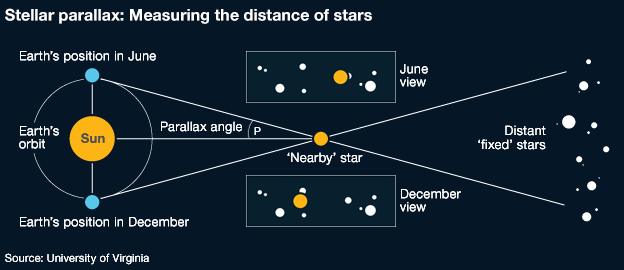Gaia 'billion-star surveyor' returns test image
- Published

Gaia's test image of the young star cluster NGC1818 in the Large Magellanic Cloud
Europe's billion-star surveyor, Gaia, is on track to begin operations in the next two or three months.
Launched in December, the satellite has now taken up its observing station some 1.5 million km from Earth.
Engineers are currently commissioning Gaia's two telescopes and its three instruments, getting them ready to begin mapping the precise positions and motions of one-thousand-million stars.
As part of that process, an image has been produced of a small star cluster.
This grouping is sited in the Large Magellanic Cloud (LMC), a companion galaxy to our own Milky Way, some 160,000 light-years in the distance.
If the picture just released by the European Space Agency looks somewhat underwhelming, that is not really surprising - taking pretty vistas of the sky is not what this mission is about.
Rather, Gaia's job when operational will be to track and characterise points of light moving across its big camera detector - be those stars, asteroids, comets or the flashes generated by exploding objects such as supernovae - to work out how far away they are and how they are moving in relation to everything else.
Prof Gerry Gilmore, the UK Gaia principal investigator from Cambridge University, told BBC News: "This image tells us that they've turned on the electronics, that they've turned on the computer, and that they've turned on Gaia's incredible British-built camera - and it's all working.

Gaia - The discovery machine
Gaia will make a very precise 3D map of our Milky Way Galaxy
It is the successor to the Hipparcos satellite which mapped some 100,000 stars
The one billion to be catalogued by Gaia is still only 1% of the Milky Way's total
But the survey's quality promises a raft of discoveries beyond just the star map
It will find new asteroids and planets; It will test physical constants and theories
Gaia's sky map will be the reference to guide future telescopes' observations

"Gaia was not designed to take Hubble-like pictures; this is not its operating mode at all. What it will eventually do is draw little boxes around each of the stars you see in this picture and send just that information to the ground."
The satellite has been given an initial mission duration of five years to make its 3D map of the sky.
By repeatedly viewing its targets, it should get to know the brightest stars' coordinates down to an error of just seven micro-arcseconds - an angle equivalent to a euro coin on the Moon being observed from Earth.
One of the benefits of such study will be to refine the distance "ladder" used to measure scale in the Universe.
This ladder describes a number of techniques that lean on each other in a stepwise fashion to calculate the separation between Earth and some of the most far flung objects in the cosmos.
To the bottom of this ladder is the trigonometric parallax technique that Gaia will employ to measure distances.
Traditionally, this has only worked with stars inside the Milky Way. But Gaia's advanced optics will for the first time extend parallax to stars in the LMC.


As the Earth goes around the Sun, relatively nearby stars appear to move against the 'fixed' stars that are even further away
Because we know the Sun-Earth distance, we can use the parallax angle to work out the distance to the target star
But such angles are very small - less than one arcsecond for the nearest stars, or 0.05% of the full Moon's diameter
Gaia will make repeat observations to reduce measurement errors down to seven micro-arcseconds for the very brightest stars
Parallaxes are used to anchor other, more indirect techniques on the 'ladder' deployed to measure the most far-flung distances

In the past, the cloud's position has been determined only indirectly by studying the next rung up - the characteristic pulsations of particular stars known as Cepheids.
Having some parallax measurements in the LMC instead will allow astronomers to better calibrate the ladder and its various techniques, such as Cepheid pulsations. And that should mean researchers having more confidence in the figures calculated for even greater distances.
Prof Gilmore said: "Currently, we have precision distances - i.e. to 1% accuracy - to only one Cepheid star, which is Polaris (the North Star). So the whole distance scale to the Magellanic clouds depends on very shaky foundations. Gaia will be the 'sanity check' on the distance ladder where all of our different methods overlap.
"But Gaia will do even more because until now the accuracy to which we could work meant that we had to assume the Large Magellanic Cloud was a single point at one distance. We've had to average out properties. With Gaia, we will resolve out the LMC in three dimensions and that will tell us far more about its structure, and that will really open it up to proper scientific study."
Jonathan.Amos-INTERNET@bbc.co.uk and follow me on Twitter: @BBCAmos, external
- Published8 March 2013

- Published19 December 2013

- Published28 November 2013
- Published21 August 2013
- Published10 October 2011
- Published20 July 2010